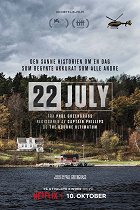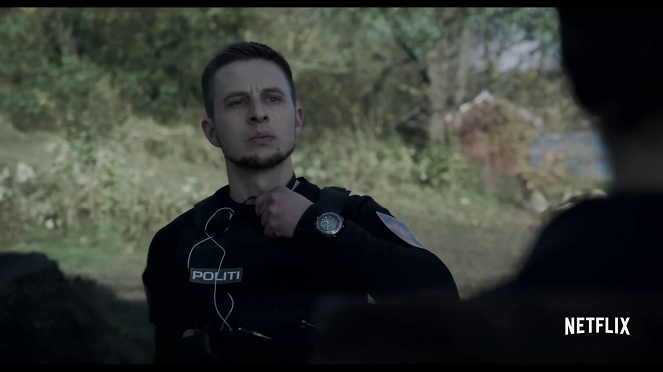Directed by:
Paul GreengrassScreenplay:
Paul GreengrassCinematography:
Pål Ulvik RoksethComposer:
Sune MartinCast:
Jonas Strand Gravli, Thorbjørn Harr, Anders Danielsen Lie, Seda Witt, Lars Arentz-Hansen, Jon Øigarden, Anneke von der Lippe, Øystein Martinsen, Maria Bock (more)VOD (1)
Plots(1)
Paul Greengrass tells the true story of the aftermath of Norway’s deadliest terrorist attack. On 22 July 2011, 77 people were killed when a far-right extremist detonated a car bomb in Oslo before carrying out a mass shooting at a leadership camp for teens. 22 July uses the lens of one survivor’s physical and emotional journey to portray the country’s path to healing and reconciliation. (Venice International Film Festival)
(more)Videos (1)
Reviews (11)
Paul Greengrass is a master of immersive atmosphere and has reaffirmed it with this film. If someone seems to find the scene of the absolutely crazy massacre rushed and non-captivating, I feel really sorry for them (and it may well be the founder of FilmBooster), because I haven't seen anything more repulsive in a long time. Besides Greengrass, the representative of Breivik, from whom radiates unadulterated fear, does his share, and the longer he is in the film and when he turns into an exquisite psychopath from an originally silent character, then that fear is even greater. In addition to Breivik, we also see the consequences of his actions, which one of the families must deal with, we will also get to know his attorney and feel the pressure on the Prime Minister of Norway... It seems to me that the film really had everything. I can't say I enjoyed watching it, but it was one of those memorable experiences. I guess like... Well yes, probably like Greengrass' United 93.
()
I am reluctant to use the word “complex”, which for me means a film that offers numerous opposing perspectives and ambivalent impressions, which is not the case in Greengrass’s factually concise docudramatic reconstruction, in which he constructs two relatively unambiguous ideological positions (similar to Bloody Sunday), which he pits against each other so that he can offer the intended political statement in the end (threats against Lippestad only bring shades of grey into the narrative, but they are not laid out in greater detail and can also be seen as a means of supporting the argument for the power of democracy, which, regardless of the possible risks, cannot serve only those who deserve it, but everyone). ___ Good versus evil, love versus hate, a deranged individual versus a community which, thanks to mutual support and cooperation following the trauma, can get back on its feet and face evil. With his movements, cold-blooded thinking and belief in his own infallibility, Breivik is reminiscent of a machine. If we learn anything about his motives, it is from his mother’s statement, which the attorney needs because of the trial, or thanks to the fact that he has become a research subject for psychologists. In the scenes from the prison with a predominance of cold colours, he is aggressively set apart from his surroundings by his red shirt. Conversely, through flashbacks and subjective sounds, we “see into the mind” of the traumatised, insecure and vulnerable Viljar and get to know him in a number of situations with his supportive loved ones in which he gives expression to his emotions. We not only observe him, but we experience who he is. Instead of a “traitor”, a “Marxist” or a “member of the elite”, as Breivik blanketly labels his victims, we get to know an actual person and his story. As we are shown through numerous parallels in the way the two figures are depicted, Viljar is not from a certain moment most at risk from the wounds that he suffered, but rather from the possibility that he, like Breivik, is starting to become isolated from others and will stop seeing himself as a member of the broader community.___ The rhythm of the smoothly flowing narrative is masterfully set by the large number of viewpoints between which Greengrass cuts. After the dynamic beginning, which offers a broad variety of rapidly alternating viewpoints, a calming occurs and we watch only Breivik and Viljar for a moment. If the narrative jumps to another character, thanks to the prologue we are already familiar with them and we know what role they play in the web of relationships and what element of Norwegian society they represent. After this slowing down and narrowing of focus, the film also transitions from individual actions, recorded step by step almost in real time, to their more general sociological and political implications. Of course, they still serve mainly to support the arguments employed in the final trial. The whole film is a textbook example of how to apply dialectical logic in practice. It does not try to depict the reality of polarised Europe in all its complexity, but rather as a clash of two principles, which it succeeds in doing in a very factual and extremely suggestive manner. 85%
()
(less)
(more)
This is very challenging material to film (and I mean this not only from a moral and ethical standpoint but also in terms of content). Making a two-hour film about such a horrific event is no easy task. However, my concerns eased a bit when I found out that Greengrass was at the helm. The result is therefore above average, though not great (but blaming him for that would be nonsensical). The initial half-hour sequence, culminating in the shooting on the island, is horrifying—I still get goosebumps from it, as it was truly difficult to watch. But then comes almost two hours where multiple storylines unfold. And here's where the problem lies because the film starts to drag, to put it mildly. It has its admirable moments—the scenes with the actor portraying Breivik are very well done, and the final court scene is highly emotional—but I would have cut a good half hour from it. For instance, I would have given more screen time to the Prime Minister, who wasn’t given much attention. All in all, it’s a film everyone should see, but in terms of quality, it doesn’t quite match up to Greengrass’s previous work with a similar theme (United 93). However, it's still a solid piece of craftsmanship, no doubt about that. I’m giving it 75%.
()
The attack itself is over and done within the first thirty minutes and it is not as spellbinding as I would have expected, and the rest of the movie shows society trying to come to terms with the tragedy. The traumatised male survivor and his family, Brejvik’s lawyer and his family, Brejvik himself and the court proceedings. For a Greengrass film, 22 July has a surprisingly mechanical, boring narrative that relies on the depth of suffering of a traumatized boy in contrast to the murderer’s shocking serenity founded on his political convictions. There is some sort of message and some merit in its information value, but as for conveying the horror of the tragedy to the audience, its competitor, Erik Poppe’s Utøya: July 22 has the upper hand.
()
Greengrass’s simple interpretation of a terrorist attack and the subsequent events holds a hidden message involving fear of what the world is coming to. Instead of Breivik, it focuses more on a boy, Viljar, riddled with gunshot wounds, his gradual recovery and return to life. The confrontation in court is powerful, with no unnecessary ideological frills. Precise acting performances, powerful supporting scenes (the brain surgery, fitting glass eyes, the final farewell with the lawyer) and the effort to capture reality as precisely as possible are the main highlights of this movie. On the other hand, the endeavor to give every aspect sufficient space means that it lacks a certain complexity. If it weren’t for the excessive length, I would give it a full five-star rating.
()
Gallery (41)
Photo © Netflix


